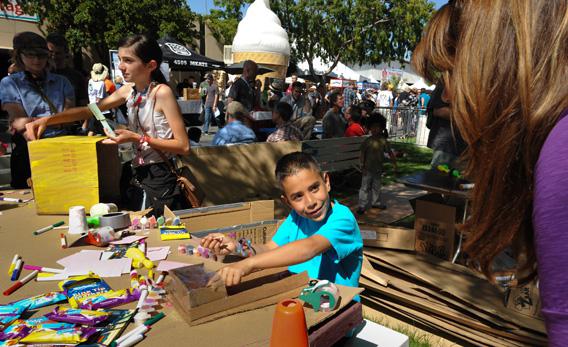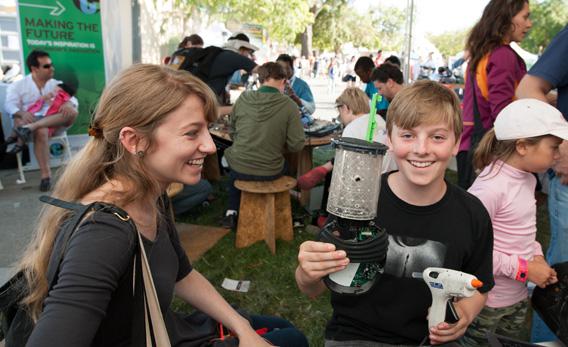Read more from Slate’s special issue on science education and give us your best ideas for raising the next generation of scientists and engineers.
On a morning visit to a Northern California middle school, I saw not a single student. The principal showed me around campus, but I didn’t see or hear students talking, playing, or moving about. The science lab was empty, as were the library and the playground. It was not a school holiday: It was a state-mandated STAR testing day. The school was in an academic lockdown. A volunteer manned a table filled with cupcakes, a small reward for students at day’s end.
This is what the American public school looks like in 2012, driven by obsessive adherence to standardized testing. The fate of children, their schools, and their teachers are based on these school test scores. I wondered what kind of tests the students were taking. The California Department of Education’s STAR website has sample test questions, and I started looking through them randomly. Soon, I came across the following reading comprehension question about the proper use of a microscope, shown in the illustration below.
The illustration is the prelude to the actual question, which is:
The microscope lens should initially be placed close to the glass slide:
A. Because focus is achieved by moving closer to the specimen.
B. Because the specimen on the slide will be in perfect focus.
C. To avoid breaking the glass slide when adjusting the focus.
D. To maintain distance from the microscopic stage.
Try to guess the right answer. I’ll be honest. I couldn’t figure it out. Worse, I didn’t care to. Here’s how kids answer the question.
Results:
A. 28 percent of students gave this response.
B. 22 percent of students gave this response.
C. 41 percent of students gave this response. (Correct response)
D. 8 percent of students gave this response.
Nearly 60 percent of kids do not give the correct response. This is what test designers want. As an educator once told me, if the question was such that everyone got the right answer, then it wouldn’t be a good question. The corollary is that there are a lot of things that most kids know that we don’t test.
Reading the sample question made me think what it would be like to be tested on the procedure for silencing a cellphone. Imagine how hard it would be if you had never used a cellphone.
As I examined the test question, two things became apparent.
- The test has become a teaching tool. Since students weren’t expected to know from experience what a microscope is, the test must explain what a microscope does, what the parts are named, and how to use it.
- It failed to convey that the whole purpose of having a microscope is to see things that you can’t see with the naked eye.
I told my son-in-law about this particular question because he had just graduated from the wine program at U.C.–Davis, where he used a microscope quite a bit. He told me that at a recent family event he brought out his microscope to show what a drop of wine looked like under magnification. His grandmother, who had never looked through a microscope before, stepped up to take her first look. “My,” she said, “it looks like little grapes.” Everyone laughed, thinking she was somehow confused. Her grandson spoke up excitedly telling everyone that Louis Pasteur made the same remark upon seeing yeast cells for the first time under a microscope.
The most disturbing thing about the test question is that the test has become a substitute for direct experience. A drawing replaces reality. Too often in schools we are teaching science from textbooks—that is to say, on paper.
Learning by Doing, Learning by Making
“Learning by doing” was the distillation of the learning philosophy of John Dewey. He wrote: “The school must represent present life—life as real and vital to the child as that which he carries on in the home, in the neighborhood, or on the playground.” He also wrote that “education is not preparation for life; education is life itself.”

Photograph by Gregory Hayes.
As the publisher of Make magazine and Maker Faire, I find Dewey’s views refreshing and relevant. I see the power of engaging kids in science and technology through the practices of making and hands-on experiences, through tinkering and taking things apart. Schools seem to have forgotten that students learn best when they are engaged; in fact, the biggest problem in schools is boredom. Students sit passively, expected to absorb all the content that is thrown at them without much context. The context that’s missing is the real world.
Each year at Maker Faire in the Bay Area, we have an Education Day, when kids get to meet makers and see their creative projects. The kids interact with robots, rockets, and all kinds of contraptions. They get to make things themselves. One comment I hear from kids was that the experience was “real.” It’s a telling comment, because so many kids have come to see school as isolated and artificial, disconnected from the community.
The maker movement has the opportunity to transform education by inviting students to be something other than consumers of education. They can become makers and creators of their own educational lives, moving from being directed to do something to becoming self-directed and independent learners. Increasingly, they can take advantage of new tools for creative expression and for exploring the real world around them. They can be active participants in constructing a new kind of education for the 21st-century, which will promote the creativity and critical thinking we say we value in people like Steve Jobs.
At an educational workshop where I made my case for making, there were a number of rather skeptical educational bureaucrats who kept asking how we assess or measure something that’s experiential. How do we measure engagement? I was rather frustrated, to be honest. How do we know children are learning if we can’t test it? I put it back to them: “How do we know what we’re testing is real learning?”
I continued to think about the questions for several months. Then one day I had it in a sentence. “Making creates evidence of learning.” The thing you make—whether it be a robot, rocket, or blinking LED—is evidence that you did something, and there is also an entire process behind making that can be talked about and shared with others. How did you make it? Why? Where did you get the parts? Making is not just about explaining the technical process; it’s also about the communication about what you’ve done.
This kind of conversation is the core of Maker Faire. Makers bring what they’ve made and share it with others. They answer questions and explain how things work. They get feedback and meet others who have insights into what they’ve made. We might consider it a performance-based assessment, just like what happens in the work world.
As I walked around the middle school with the principal, we were looking at rooms that could be used to create a maker space for students. We walked into an empty room that once was the metal shop. It was perfect. I could imagine it having tools and materials and workbenches. I could imagine groups of curious kids being active, social, and mobile. She said her students would be very happy. “They never get asked to create anything,” she told me.
Also in Slate’s special issue on science education: Fred Kaplan explains why another “Sputnik moment” would be impossible. Also, share your ideas for fixing science education in the Hive. This article arises from Future Tense, a joint partnership of Slate, the New America Foundation, and Arizona State University.
